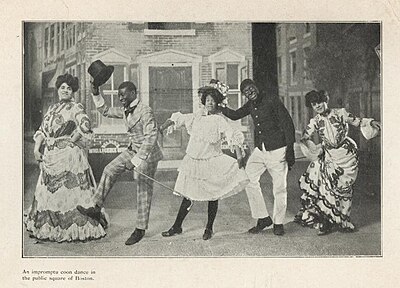Lottie Williams (actress, born 1866)

Lottie Williams (1866, Chicago – 17 March 1929, Harlem) was an American actress, singer, and dancer.[1] A pioneering performer in African-American musical theater, she is best remembered for starring in several stage works with her husband, Bert Williams, both on Broadway and in vaudeville. These included the musicals Sons of Ham (1900), In Dahomey (1903), My Tom-Boy Girl (1905), and Abyssinia (1906) among other works. She retired from the stage in 1908.
Life and career
Lottie Williams was born with the name Charlotte Louise Johnson in Chicago in 1866.[2] She was educated in the city of her birth.[1] Her first marriage to a Chicago businessman named Mr. Thompson ended upon his death,[3] and soon after this event she moved from Chicago to New York City.[4]
In 1898 Lottie joined Bert Williams and George Walker's theatrical company; first appearing with them in vaudeville under the name Lottie Thompson in Senegambian Carnival.[5] It was during the rehearsals of this show that she began a romantic relationship with Bert Williams, and the pair married on September 21, 1899.[6] After this she was credited on the stage as Lottie Williams.[7]
Williams continued to perform in the Williams and Walker company for the next decade until she retired from the stage in 1908.[8] With the company she appeared in several musicals crafted by composer Will Marion Cook, lyrcisit Paul Laurence Dunbar, and the playwright Jesse A. Shipp; including A Lucky Coon,[9] The Policy Players (as Miss Gushington),[9][10] Sons of Ham (as Gabby Slaughtry),[11] In Dahomey (as Mrs Stringer),[12] My Tom-Boy Girl (as Josie, a.k.a. the "Tom-Boy Girl"),[13] and Abyssinia (as Miss Primly).[14] Many of these shows had runs on Broadway in addition to touring the United States. [9] In Dahomey and Abyssinia in particular have been cited as two groundbreaking works in the evolution of the American musical comedy and two important early African-American musicals.[15]
In most of the Cook, Dunbar, and Shipp musicals Lottie was featured as a singer and dancer in supporting character roles. However, in My Tom-Boy Girl she was given the part of the central protagonist of Josie the 'Tom-Boy Girl'. A comedic part, the musical told the tale of a down and out New York City papergirl's unexpected inheritance of a fortune tied to an estate in Virginia. After moving into her inherited mansion, her sister Lillian in kidnapped for ransom and in order to win her back she disguises herself as the miscreant "Ragged Joe" in order to infiltrate the gang of criminals who have taken her captive. This particular show toured nationally before reaching New York City where it first played at the Metropolis Theatre in Bronx prior to appearing on Broadway at the Fourteenth Street Theatre in May 1905.[16]
In 1908 health issues forced Williams to retire from the stage,[17] and after this she dedicated herself to supporting her husband's career behind the scenes, and taking care of Bert's elderly parents who moved from California into Bert and Lottie's home in Harlem.[18] In the Spring of 1913 Lottie's sister, Carrie, died and Lottie and Bert became the guardians of Carrie's three daughters: Charlotte, Eunice, and Laura.[19] To make room for their expanding family the Williams purchased a larger four story brownstone in Harlem,[18] and the couple welcomed the children into their new home as their adopted parents.[19]
Bert Williams died in 1922, and Lottie Williams died seven years later on March 17, 1929 at their home at 2309 Seventh Avenue in Harlem.[1] She is buried next to her husband in Woodlawn Cemetery.[1]
References
- ^ a b c d "Bert Williams' Widow Is Dead". The New York Age. March 23, 1929. p. 1.
- ^ Smith, p. 35
- ^ Jasen & Jones, p. 48
- ^ Hill & Hatch, p. 167
- ^ Jasen & Jones, p. 47-48
- ^ Forbes, p. 82
- ^ Hill & Hatch, p. 167
- ^ Roth Pierpont, p. 73
- ^ a b c Sampson, p. 1436
- ^ "The Policy Players". The Play: Published Weekly in the Interests of the Theatre and Amusement. 1 (13–18). 1900.
- ^ "Sons of Ham". The Cast. 5 (7–9): XVI. 1901.
- ^ Dietz, p. 151
- ^ Dietz, p. 285
- ^ Dietz, p. 350
- ^ Dietz, p. 151-152, p. 350-351
- ^ Dietz, 285-286
- ^ Tafoya, p. 10
- ^ a b Jasen & Jones, p. 66
- ^ a b Forbes, p. 80, 231
Bibliography
- Dietz, Dan (2022). The Complete Book of 1900s Broadway Musicals. Rowman & Littlefield Publishers. ISBN 9781538168943.
- Forbes, Camille F. (2008). Introducing Bert Williams: Burnt Cork, Broadway, and the Story of America's First Black Star. Basic Books. ISBN 9780786722358.
- Hill, Errol G.; Hatch, James V. (2003). A history of African American theatre. Cambridge University Press. ISBN 9780521624435.
- Jasen, David A; Jones, Gene (2013). Spreadin' Rhythm Around: Black Popular Songwriters, 1880-1930.
- Roth Pierpont, Claudia (2016). American Rhapsody: Writers, Musicians, Movie Stars, and One Great Building. Farrar, Straus and Giroux. ISBN 9780374104405.
- Sampson, Henry T. (2014). Blacks in Blackface: A Sourcebook on Early Black Musical Shows. Scarecrow Press. ISBN 9780810883512.
- Smith, Eric Ledell (1992). Bert Williams: A Biography of the Pioneer Black Comedian. McFarland & Company. ISBN 9780899506951.
- Tafoya, Eddie (2011). Icons of African American Comedy. ABC-CLIO. ISBN 9780313380853.
